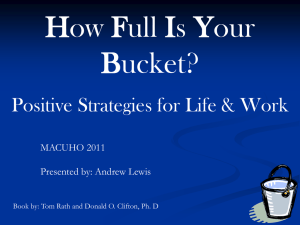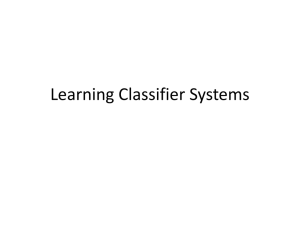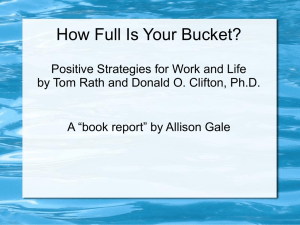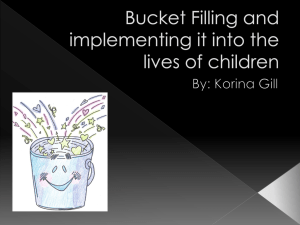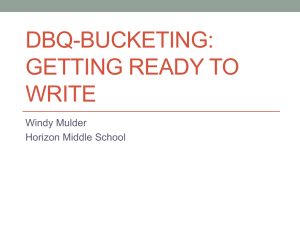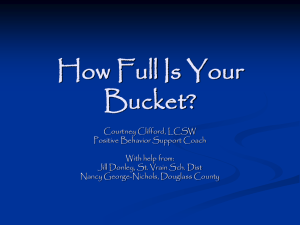Sample Presentation - Megan Shaw`s E-Portfolio
advertisement
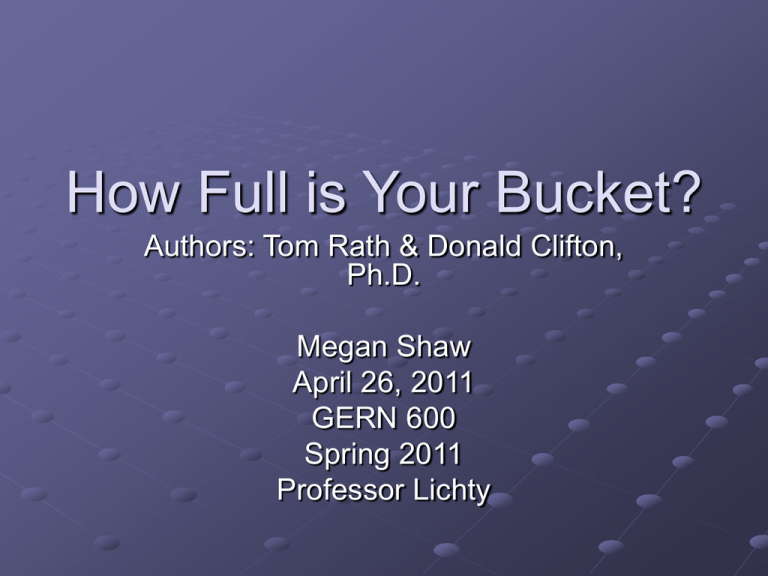
How Full is Your Bucket? Authors: Tom Rath & Donald Clifton, Ph.D. Megan Shaw April 26, 2011 GERN 600 Spring 2011 Professor Lichty Contents The Theory of the Dipper and the Bucket Case Study What is Right With People Bucket Filling in Organizations Our Negative Culture The Magic Ratio Health and Negativity: Longevity Five Strategies for Increasing Positive Emotions Activity Connection to Class Materials Conclusion References Questions The Dipper and the Bucket Each of us has an invisible bucket. It is constantly emptied or filled, depending on our daily interactions with others. Each of us also has an invisible dipper. When we do or say things that increase positive emotions in others, we are using that dipper to fill their buckets. Dipper and Bucket Cont. Conversely, when we are negative, we are using that dipper to decrease others’ positive emotions by dipping in their bucket. But, this works both ways. When we fill others’ buckets, our bucket is also filled. When we dip from others’ buckets, our own bucket is emptied in turn. Case Study Clifton reviewed a case study of American POWs that had been captured in camps during the Korean War. A phenomenon termed mirasmus raised the overall death rain in the North Korean POW camps to 38% (the highest in U.S. history). Case Study Cont. Psychological warfare: Informing Self-criticism Breaking loyalty to leadership and country Withholding all positive emotional support What is Right With People? With the evidence to show how much of an impact negative emotions had on people, Clifton set out to discover: Can positive emotions have an even stronger impact than negative emotions? Bucket Filling in Organizations Constant bucket dipping in the workplace has measurable consequences: Poorer performance Lower productivity Decreased profits Higher turnover More accidents on the job Lower customer satisfaction, innovation, and quality scores Bucket Filling in Orgs. Cont. Actively disengaged workers cost the U.S. economy $250-$300 billion a year in lost productivity alone. Why are there so many disengaged workers? According to the U.S. Dept. of Labor, the biggest reason for employees leaving their jobs is because they do not feel appreciated. 65% of Americans received no recognition last year for good work. Bucket Filling in Orgs. Cont. Employees who receive recognition and praise: Increase their individual productivity Increase engagement among their colleagues More likely to stay with their organization Receive higher loyalty and satisfaction scores from customers Better safety records/fewer accidents on the job Our Negative Culture Dr. Elizabeth Hurlock: What would happen when students received different types of feedback? 4 Groups 1. 2. 3. 4. Praise Criticized Ignored Control Our Negative Culture Cont. Results: Our Negative Culture Cont. Overall improvement: Praised: 71% Criticized: 19% Ignored: 5% Praise is a secret weapon for productivity and progress 9/10 people are more productive around positive people The Magic Ratio 3 to 1 Highest level of productivity 13 to 1 Decreases productivity Inauthentic Recognition is most appreciated and effective when it is individualized, specific, and deserved Health and Negativity: Longevity Negative emotions can cause physical symptoms Positive emotions can buffer us from depression and adverse health effects, and may increase our life span as well. Case Study: Nuns with positive emotions lived 10 years longer Health and Negativity: Longevity Cont. Barbara Fredrickson on positive emotions: Protect us from, and can undo the effects of, negative emotions Fuel resilience and can transform people Broaden our thinking, encouraging us to discover new lines of thought or action Break down racial barriers Produce optimal functioning in organizations and individuals Build durable physical, intellectual, social, and psychological resources that can function as ‘reserves’ during trying times Improve the overall performance of a group (when leaders express more positive emotions) Five Strategies for Increasing Positive Emotions 1. 2. 3. 4. 5. Prevent bucket dipping. Shine a light on what is right. Make best friends. Give unexpectedly. Reverse the Golden Rule. Activity!! Connection to Class Materials Leading as a function of management Transformational leader Visionary leadership Organizational culture Motivation Conclusion By asking yourself “What is right with people?” you can better yourself and those around you Use the Five Strategies for increasing positive emotions Answer the question: What fills my bucket? References Rath, T. & Clifton, D.O. (2004). How full is your bucket? New York, NY: Gallup Press. Schermerhorn, J.R. (2002). Management, 7th ed. Hoboken, NJ: John Wiley & Sons, Inc. Theisen, T. (2003, March 25). Recognizing all staff members is an important task. Lincoln Journal Star, p. 4A. Questions??


